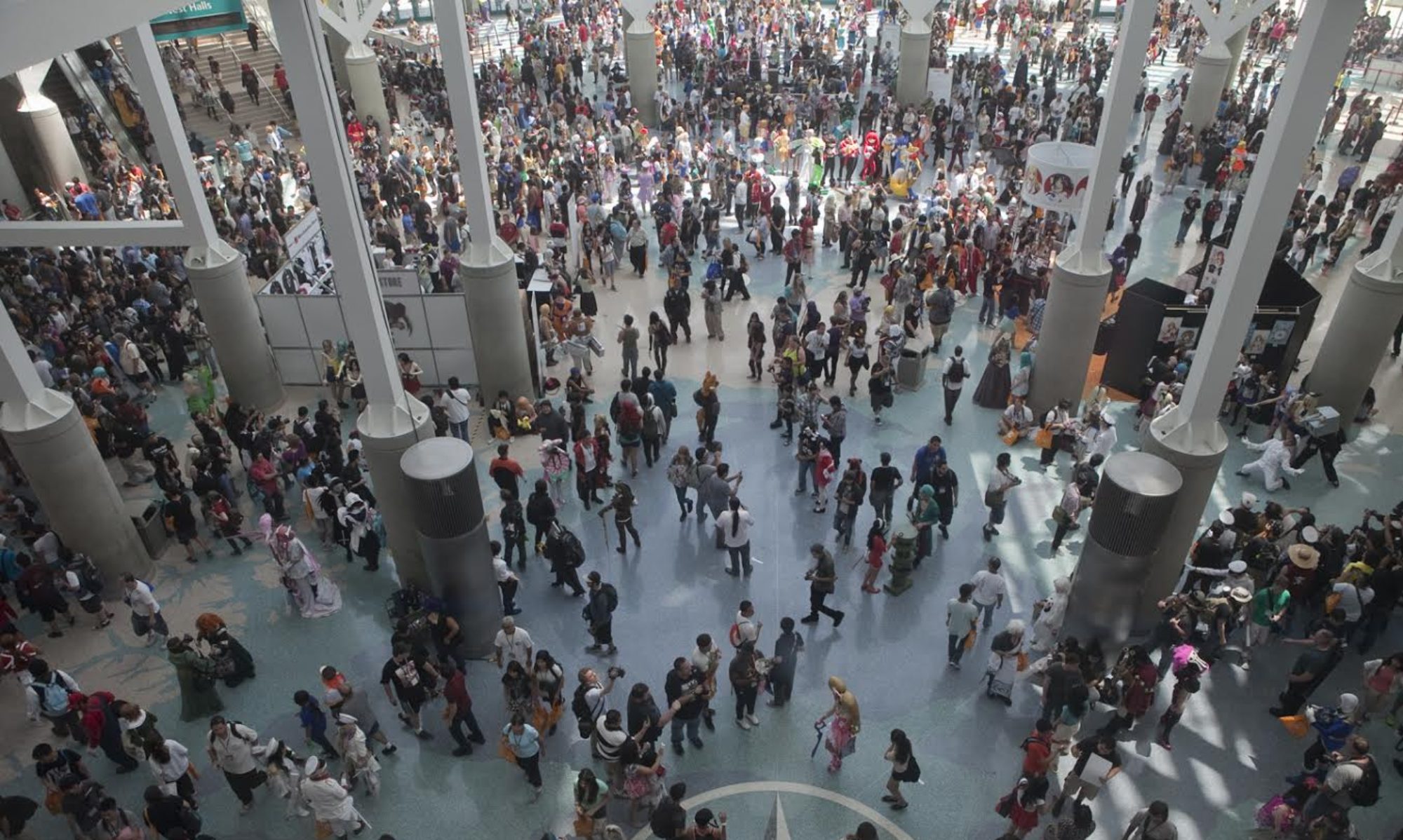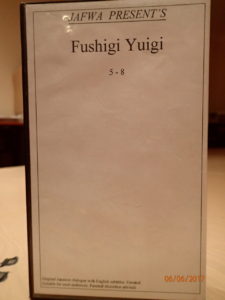Age: 49
Location: Grand Rapids, MI
When did you discover anime? I remember watching Speed Racer in 1974 when I would have been like seven. I also had some Shogun Warrior toys from when I was 10 because I thought they looked cool (still have them, BTW). But for anime as something with a specific aesthetic and history, that would be watching Robotech in 1985 when I was 17. I found it on afternoon TV in the weeks between finishing a summer job and going off to college. When I got to college, I found it on the San Francisco station and it was just wrapping back around to episode one, so a small crowd of dormmates started watching it in my room every weekday afternoon at 4. One of my roommates joined in enthusiastically; the other went on to become a literal billionaire. So, remember kids: don’t watch anime, go be evil and rich instead.
When you discovered Robotech in high school, did you recognize it as the same medium that the Speed Racer of your childhood was? I knew it was related, because the visual style was obviously different from American TV cartoons. But I didn’t get a full understanding until I found written sources I could learn from. They did a coffee table book for Robotech, available at comic book shops, and its last chapter was an entire history of manga and anime, so that’s where I first learned about Osamu Tezuka, Leiji Matsumoto, and big titles like Gundam that hadn’t come over yet, etc.
What appealed to you about anime when you first discovered it? The storytelling, without a doubt. There was little continuity in 1980s TV, and only anime (and miniseries) had the novelistic approach that’s so popular in scripted TV today. In a way, Robotech was kind of like our animated soap opera, as we were all on pins and needles about whether Rick would end up with Minmay or Lisa, or if Dana would get Zor’s head put back together before it was too late. But it was better than a soap opera because it didn’t just go on forever: things changed, people died, and each chapter of the series came to a solid conclusion.
What would you say was the most popular anime at the time? Well, I’ve said enough about Robotech. Rich, a guy down the hall, also told us about having seen Star Blazers a few years earlier where he grew up, but I’d never seen it (I guess we didn’t get it in Detroit?). As I started getting exposed to the early fandom (see next few questions), I found out about stuff that was popular in fan circles in the late ’80s like Kimagure Orange Road and Urusei Yatsura, though I had no access to it at the time. And when I’d go to hobby shops that imported model kits, I learned the names of other mech franchises of the day: Gundam, Orguss, Dunbine, and the rest.
Your story is different from others about the ’90s because it sounds like you were able to watch stuff legally on American TV. Do you remember what channel? As you got more into anime, how did you find stuff that wasn’t on TV? As the saying goes, “ANIME DEMANDS SUFFERING!” It was actually a little better in the ’80s, because in a big city (I grew up in Detroit and went to college in the Bay Area, then came back to Michigan), you’d have three network affiliates (ABC, NBC, CBS) and then some independent stations. The network stations had game shows and soap operas for their daytime schedules, and the independents would run cartoons. Usually, there’d be an obvious pecking order among the independents: like in Detroit, channel 50 would have the best stuff, then 20, and then 62. Anime, being cheaper than first-run syndication like GI Joe or Transformers, would show up on the lesser independents. So if you really dug deep, and looked at TV Guide listings for 6AM on the crappiest channels, you’d find stuff like Macron One, Tranzor Z, or Teknoman. And remember, Sailor Moon and Dragon Ball both got their American start as syndicated shows on these stations. When I was out of grad school and living in an apartment with my girlfriend in Lansing, MI, I found that if I moved the TV and carefully re-pointed the antenna, I could pick up the Grand Rapids station that played Exo-Squad, an US cartoon that was explicitly an attempt to make an American anime-style space opera (in recent years, its creators have straight up said they were inspired by Gundam). In the ’90s, these independents became the Fox, WB, and UPN stations, and the cheap anime got replaced by the Fox and WB kids’ blocks.
Sometimes you could find video rental stores that would go deep on anime. Not Blockbusters or Hollywoods, but in Lansing we had a store called “Video To Go” that went deep in many categories, and they had all of Bubblegum Crisis along with Project A-ko and the Dirty Pair movies, plus a generous selection of hentai of course (it’s hard to overstate how the mere existence of that stuff helped compartmentalize anime as its own distinct thing, if only to help separate it from the cartoons for the kiddies).
What was it like to be a part of anime fandom at the time? Only a few people knew that there was a fandom or what to call it, and I wasn’t really in that group. It wasn’t until Carl Macek gave over the last 30 pages of his Robotech coffee table book to praising the rest of anime and manga that I could get a sense of what was out there and what I could seek out, at which point I’d get into stuff like Trish Ledoux’s “Animag” magazine at the comics shop. So, for me, it was a personal journey to learn more about this stuff, not so much an engagement with a fandom.
Was anime fandom something you could share openly? From what you told me, it sounds like all your college dormmates were fans, too. Except that there were only one or two other clearly anime things around in the mid-’80s (Star Blazers and Voltron), so anime wasn’t quite enough to identify as its own form or genre and merit a lot of discussion. So the small group of us following Robotech were mostly only into Robotech, and it was just one of many interests we had. Also, I did have one friend who got so obsessed with it, seeking out model kits and comics, that he neglected his studies and failed out of school, so that was kind of a black mark that put our enthusiasm in check.
Anime kind of crossed over with comic book culture too, most prominently through Marvel publishing a colorized version of the Akira manga, so some of my comic-book fans went with me to the Akira movie when that hit the local independent theater, though they weren’t interested in anime much beyond that.
Was the Internet a part of fandom at the time? Only for super nerds. I was doing computer science at Stanford, and it wasn’t until my junior year until I could get access to Usenet and rec.arts.anime, which was the English-speaking anime world’s most significant online presence for a time. This was also right around the time of the American animation renaissance — at one point, people wanted to post about American cartoons on rec.arts.anime because there wasn’t a better place for it, at least not until rec.arts.animation and alt.tv that groups for those movies and TV shows emerged. I got really into the American renaissance (The Little Mermaid, Tiny Toons, etc.) so around 1990 or so, I drifted away from anime for a while and into these online communities.
Do you remember your first convention? Anime Weekend Atlanta in like 1997 or something. I only found out about it because they happened to be running their early website on the same server as something else I was into (I think the Gundam site from one of the editors of MacAddict magazine?). So that would have been like AWA 4 or something. I’d never been to a pop culture convention, so I didn’t do much the first time, just bought a bunch of Final Fantasy VII stuff in the dealer’s room and attended the Cartoon Network panel (which had the voice actors from Space Ghost Coast to Coast, like George Lowe, who were a total blast but of course had nothing to do with anime). In returning to AWA in later years, I’d get more into watching shows in viewing rooms, learned about AMVs, etc.
What did your family think about your interest in anime? (And what do they think about it now?) In both directions, zero interest. My parents are still alive, and when I mention I’m speaking at an anime con, they politely change the subject, so I don’t stick with it. I once mentioned anime to my wife’s grandmother and she started in on a Pearl Harbor rant, so that was fun. I have kids of my own (ages 15 and 12), but they’re not into anime at all, and it’s not something I’ve pushed; I’m happier they find their own stuff. My wife watched a little anime with me over the years, and she liked some of it (Project A-ko, His and Her Circumstances), but it’s not something she’d ever watch on her own.
For you personally, what’s the biggest difference between anime fandom then and anime fandom now? Mostly that it’s identifiably its own thing. Anime in the ’80s was largely attached to other fandoms. It was another source of sci-fi action, since there was only so much of that available domestically, even after the “Star Wars” boom. So a lot of where I’d learn about anime was from a comic books store where they had the American comics of Robotech, Lum, and Ranma 1/2, and then import toys and model kits. The store I went to in Palo Alto, CA (“Comics And Comix”), would show random videos on a tiny TV on the counter on Fridays, usually American stuff like the terrible Pryde of the X-Men pilot, but sometimes anime—they had a tape (unsubbed) of the Akira movie before it came out in theaters here, and Char’s Counterattack, which was surely the first fansub I’d ever seen.
Today, you also have all these other genres of anime that even if they had existed back then, wouldn’t have been brought over. The economics of broadcast TV and even for-sale VHS tapes demanded more fans than you’d get for unconventional genres like moé or BL.
The other role anime served at the time was as something for people generally interested in animation. The late ’70s and early ’80s were the nadir of American animation, so some people interested in animation found anime compelling if only because anime directors knew what an over-the-shoulder shot was (because clearly nobody at Hanna-Barbera or DiC did). Along with anime, I was digging into stuff like Ralph Bakshi’s movies and the UPA cartoons from the 1950s, just because I was so frustrated with how plan bad US animation was, at least until we got the renaissance with Roger Rabbit, The Little Mermaid, Tiny Toons and all that stuff.
Chris can be reached on Twitter.


